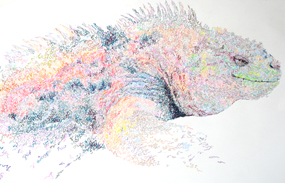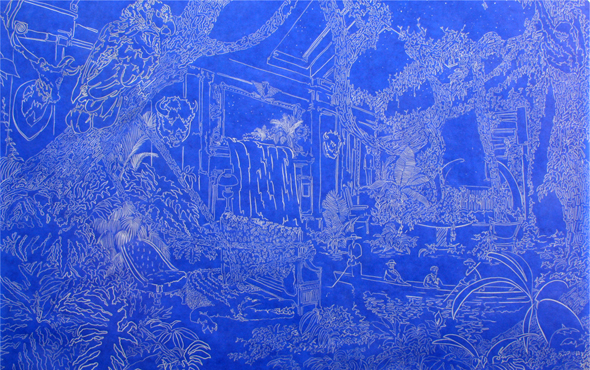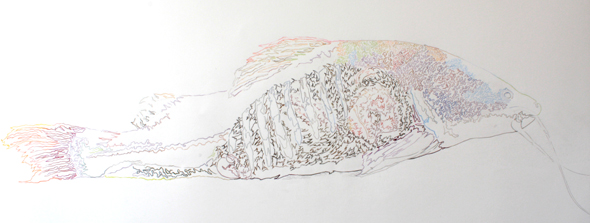River of Doubt
Join the Harmony Blog at a studio visit with artist Alexander White as he discusses how Teddy Roosevelt’s journey inspired the drawings in his first solo show.
Harmony: You have a lot of different pieces here. Tell us about the unifying idea for the show.
White: The show is loosely based on the expedition Teddy Roosevelt took in the Amazon in the early 1900s. He made an agreement with the Brazilian government that if he managed to go down this river, he got to put his name on it. So he managed to convince a team to redirect the trip “to do something a little more extreme than they had originally planned” to go down this river that had never been explored. They were completely unprepared, but they just kept on powering through. By the end of the trip they all had malaria and tropical fever and Roosevelt had a blood infection from an accident. A few of the porters had shot each other, one of them got hurled over a cliff and died in some rapids and another ran off.
The drawings were inspired by what Roosevelt took into the trip, his own cultural expectations of using nature to his advantage, exploiting it, hunting and collecting animals to take back to his estate where he’d turn them into wall trophies. But because this trip was so taxing on him and his team, nature slowed him down and put a stop to his initial ambitions. The trip became about survival. And you could you even take it a step further and say what he brought back to his house in Sagamore Hill in Long Island was a bit of the jungle. He ended up dying a few years later of the same contracted illnesses he got there, the malaria and the blood infections.
Harmony: One of the things that strikes me in this triptych, this idea of the jungle pushing through. It feels like it’s growing inside.
White: Yeah overtaking him. When I started to look into this story and into this adventure that went awry, I was interested in the two totally different ideas of what he was expecting and what he actually encountered and the fact that this man pretty much started our whole awareness of nature as a nation, through the national parks. He ended up being really humbled by nature and put in his place.
Harmony: Tell us about the bird man.
White: The trip was underwritten by the Museum of Natural History which Teddy Roosevelt’s father helped start. Teddy Roosevelt had always been connected with all the different scientists and scholars and had always wanted to plan a trip to the South American jungle with the Natural History Museum. He brought a mammalogist and an ornithologist with him. They were going to collect specimens. Traditionally when you go on a trip like this you name animals after yourself. So this is Celeste Roosevelti, who is half Roosevelt, half woodpecker.
Harmony: How did you encounter this story? And what about it spoke to you or spoke to your practice before it? Are there elements to Roosevelt’s trip that resonate with what you were doing before?
White: His trip was a way for me to understand where we, as a culture, have gotten our ideas of nature, our ideas of appropriating or exploiting nature. We use natural resources to our own advantage, extracting minerals and materials. Rarely do we pay attention to how to get it, how to rebuild it or how to keep it sustainable.
 |
 |
The first drawing I was working on was the man laying down here (Lonely River). The more I drew him he ended up being taken over or in a state of rest, of peacefulness. These animals started to emerge that were almost healing him or giving him some kind of a support and as they become more and more present, it occurred to me that this was some sort of businessman or an industrialist or somebody that had been detached from nature.
Harmony: So this was something you were working on before you came across the Roosevelt story?
White: Yeah, I had a studio visit and somebody came in and said wow you should really look into this story of Teddy Roosevelt so I picked up a biography on his South American expedition by Candice Millard. That ended up opening the door to the whole world of that adventure leading to these drawings. Like this drawing inspired by a story of them catching a river fish. They were desperate for food. They never got a good briefing or training on how to live off the land and the whole time it was expected that they would find this land of plenty of animals and fish, but when they arrived they couldn’t hunt and they couldn’t fish and they didn’t know how to live off the land. Finally they end up catching this giant fish. It’s a river catfish that they opened up to find a half eaten monkey inside and so of course they think to themselves, “Oh my god, here we are, floating down this river, swimming in the river, completely exposed to these things and there’s this fish swimming around that eats not only monkeys but is fabled to eat small children and humans.”
Harmony: Do they end up eating the fish?
White: Of course. They ate whatever they could. The only thing they never ate were the porter’s dogs. In one of the triptych drawings you have them all lamenting their dog that had been struck by an arrow by a native. For me it’s fun to draw that in the context of all this taxidermy because there’s the irony that they care about this dog they picked up for this few dozen miles on the river and fed and kept them as company. Meanwhile they’re off slaughtering anything that walks or flies.










Hi, congratulations to you both for the work and the blog about it. It’s really impressive Alexander, your work, your subject and your stance. Hope to see more like this! All the best,
Angeles